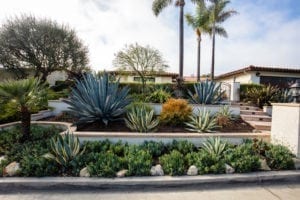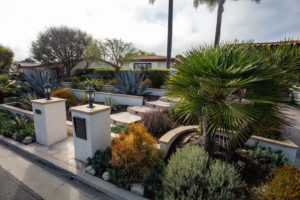In contemporary landscaping, the notion of a lawn-free front yard design is gaining ground. Also, this is fueled by a growing consciousness around environmental sustainability, water conservation, and the pursuit of low-maintenance, eco-friendly outdoor spaces.
While the benefits of this approach are compelling, it’s crucial to thoroughly consider the potential drawbacks associated with such a design choice.

Pros
1. Environmental Sustainability
By eliminating traditional lawns, homeowners can substantially diminish water consumption and the use of harmful pesticides and fertilizers. Thereby, contributing significantly to a more sustainable and ecologically balanced environment.
2. Water Conservation
Lawn-free front yards offer a practical solution for water conservation, particularly in regions vulnerable to drought and water scarcity, as they significantly curtail the need for frequent watering.
3. Low Maintenance
By eliminating the need for regular mowing, trimming, and watering, a lawn-free front yard design considerably reduces the time, effort, and resources typically required for lawn maintenance. Then, this makes it an attractive option for those seeking a low-maintenance outdoor space.
4. Space for Creativity
Removing traditional grass lawns opens up ample opportunities for incorporating a diverse range of plants, hardscaping features, and other creative elements. Besides, this allows homeowners to infuse their front yards with unique character and visual appeal that aligns with their personal taste and style.
5. Promotion of Native Wildlife
Opting for a lawn-free front yard promotes the cultivation of native plants, creating a natural habitat that can attract local wildlife, including birds, butterflies, and beneficial insects. Also, this fosters biodiversity and contributes to the overall health and balance of the local ecosystem.
6. Reduction of Pollution
A lawn-free front yard reduces reliance on gas-powered lawn maintenance equipment. Thereby, minimizing the emission of pollutants and noise, resulting in a cleaner, quieter, and more environmentally friendly neighborhood.
7. Enhanced Outdoor Living
The absence of a traditional lawn provides the opportunity to create functional outdoor living spaces, such as cozy seating areas, fire pits, or even small garden retreats, facilitating more opportunities for relaxation, entertainment, and quality time with family and friends.
8. Long-Term Cost Savings
Despite potentially higher initial costs, a lawn-free front yard design can yield significant long-term savings through reduced water consumption, minimal maintenance requirements, and the elimination of ongoing lawn care expenses, making it a prudent financial investment over time.
9. Personalization and Customization
With the flexibility to incorporate various artistic and landscaping elements, a lawn-free front yard allows homeowners to infuse their outdoor space with unique and personalized touches that reflect their individual style, preferences, and creative vision.
Cons
1. Aesthetic Concerns
The absence of a traditional lawn may not appeal to everyone, as some people prefer the lush green look of a well-maintained grassy yard, potentially impacting the overall curb appeal of the property and the neighborhood.
2. Upfront Costs
Transitioning to a lawn-free front yard design often involves substantial upfront expenses, including the removal of existing turf, installation of alternative landscaping elements, and potentially the incorporation of suitable irrigation systems, which can strain the initial budget.
3. Design Complexity
Planning and designing a lawn-free front yard require careful consideration to ensure a cohesive and visually appealing layout, which can be more complex compared to the relatively straightforward planning involved in maintaining a traditional lawn.
4. Limited Play Space
Families with children or pets might find a lawn-free front yard restrictive in terms of outdoor play space, especially if alternative recreational areas are not incorporated into the design, potentially limiting certain outdoor activities and playtime for children and pets.

Considering these comprehensive elaborations of the pros and cons of a lawn-free front yard design can guide homeowners in making an informed decision that aligns with their preferences, values, and long-term objectives for their outdoor living space.
To gather more information, you can check out Top 20 Outdoor Living Room Ideas for Al Fresco Entertaining.


